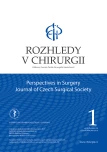The timing of ERCP in acute biliary pancreatitis
Authors:
R. Svatoň 1; Z. Kala 1
; I. Novotný 1; J. Trna 2,3; T. Andrašina 4
; L. Kunovsky 1,2
Authors‘ workplace:
Chirurgická klinika Fakultní nemocnice Brno a Lékařské fakulty Masarykovy univerzity
1; Interní gastroenterologická klinika Fakultní nemocnice Brno a Lékařské fakulty Masarykovy univerzity
2; Gastroenterologická ambulance, Interní oddělení, Nemocnice Boskovice
3; Klinika radiologie a nukleární medicíny Fakultní nemocnice Brno a Lékařské fakulty Masarykovy univerzity
4
Published in:
Rozhl. Chir., 2019, roč. 98, č. 1, s. 10-13.
Category:
Review
Overview
Despite several studies, the role and timing of endoscopic retrograde cholangiopancreatography (ERCP) in the case of acute biliary pancreatitis (ABP) remains a subject of discussion.There is a clear indication of early ERCP within 72 hours in patients with ABP andcholedochal obstruction, moreover the ERCP within 24 hours in cases of cholangitis. However, the role of ERCP in patients with ABP without symptoms of cholangitis or concrements obstructing the bile duct is controversial. If ABP is indicated for the ERCP, the earlier the ERCP is performed the less complications it is associated with. The decision to perform ERCP is often based on findings from a biochemical and transabdominal ultrasound examination. The results of these examinations may, but may not, confirm the presence of stones in the choledochus. An effective and safe method approaching the sensitivity of ERCP in the diagnosis of concrements in the choledochus is endoscopic ultrasonography (EUS) and magnetic resonance cholangiopancreatography (MRCP). The cholecystectomy should be performed to prevent a recurrence of pancreatitis and biliary problems after the successfully treatment of ABP.
Key words:
acute biliary pancreatitis − choledocholithiasis − cholangitis − endoscopic retrograde cholangiopancreatography
Sources
-
Mitchell RM, Byrne MF, Baillie J. Pancreatitis. Lancet 2003;361:1447–55.
-
Frossard JL, Steer ML, Pastor CM. Acute pancreatitis. Lancet 2008;371:143−52.
-
Acosta JM, Pellegrini CA, Skinner DB. Etiology and pathogenesis of acute biliary pancreatitis. Surgery 1980;88:118–25.
-
Neoptolemos JP, Carr-Locke DL, London NJ, et al. Controlled trial of urgent endoscopic retrograde cholangiopancreatography and endoscopic sphincterotomy versus conservative treatment for acute pancreatitis due to gallstones. Lancet 1988;2:979–83.
-
Acosta JM, Katkhouda N, Debian KA, et al. Early ductal decompression versus conservative management for gallstone pancreatitis with ampullary obstruction: a prospective randomized clinical trial. Ann Surg 2006;243:33−40.
-
Anderloni A, Repici A. Role and timing of endoscopy in acute biliary pancreatitis. World J Gastroenterol 2015;21:11205−8.
-
Byrne MF. Gallstone pancreatitis – who really needs an ERCP? Can J Gastroenterol 2006;20:15−7.
-
Loperfido S, Angelini G, Benedetti G, et al. Major early complications from diagnostic and therapeutic ERCP: a prospective multicenter study. Gastrointest Endosc 1998;48:1–10.
-
Kiriyama S, Kozaka K, Takada T, et al. Tokyo Guidelines 2018: diagnostic criteria and severity grading of acute cholangitis (with videos). J Hepatobiliary Pancreat Sci 2018;25:17−30.
-
Peng WK, Sheikh Z, Paterson-Brown S, et al. Role of liver function tests in predicting common bile duct stones in patients with acute calculous cholecystitis. Br J Surg 2005;92:1241−7.
-
Maple JT, Ben-Menachem T, Anderson MA, et al. The role of endoscopy in the evaluation of suspected choledocholithiasis. Gastrointest Endosc 2010;71: 1–9.
-
Stabuc B, Drobne D, Ferkolj I, et al. Acute biliary pancreatitis: detection of common bile duct stones with endoscopic ultrasound. Eur J Gastroenterol Hepatol 2008;20:1171−5.
-
Tse F, Yuan Y. Early routine endoscopic re-trograde cholangiopancreatography strategy versus early conservative management strategy in acute gallstone pancreatitis. Cochrane Database Syst Rev 2012. Available from: doi: 10.1002/14651858.CD009779.pub2.
-
Rustagi T, Njei B. Timing of ERCP and outcomes of patients with acute gallstone pancreatitis: a nationwide population based study. Gastrointest Endosc 2015;81:Suppl. AB405.
-
Fan ST, Lai EC, Mok FP, et al. Early treatment of acute biliary pancreatitis by endoscopic papillotomy. N Engl J Med 1993;328:228−32.
-
Folsch UR, Nitsche R, Ludtke R, et al. Early ERCP and papillotomy compared with conservative treatment for acute biliary pancreatitis. The German Study Group on Acute Biliary Pancreatitis. N Engl J Med 1997;336:237−42.
-
van Baal MC, Besselink MG, Bakker OJ, et al. Timing of cholecystectomy after mild biliary pancreatitis: a systematic review. Ann Surg 2012;255:860−6.
-
Greenberg JA, Hsu J, Bawazeer M, et al. Clinical practice guideline: management of acute pancreatitis. Can J Surg 2016;59:128−40.
-
Krška Z. Akutní pankreatitida – komplexní problematika. Rozhl Chir 2012;91:692−6.
-
Gurusamy KS, Nagendran M, Davidson BR. Early versus delayed laparoscopic cholecystectomy for acute gallstone pancreatitis. Cochrane Database Syst Rev 2013. Available from: doi: 10.1002/14651858.CD010326.pub2.
-
Stibůrek O, Trna J, Šenkyřík M, et al. Časování chirurgické a endoskopické terapie akutní biliární pankreatitidy v podmínkách terciární nemocnice v České republice. Vnitř Lék 2014;60:417−22.
-
Trna J, Vege SS, Pribramska V, et al. Lack of significant liver enzyme elevation and gallstones and/or sludge on ultrasound on day 1 of acute pancreatitis is associated with recurrence after cholecystectomy: a population-based study. Surgery 2012;151:199−205.
Labels
Surgery Orthopaedics Trauma surgeryArticle was published in
Perspectives in Surgery

2019 Issue 1
- Metamizole vs. Tramadol in Postoperative Analgesia
- Metamizole at a Glance and in Practice – Effective Non-Opioid Analgesic for All Ages
- Possibilities of Using Metamizole in the Treatment of Acute Primary Headaches
Most read in this issue
- Spontaneous retroperitoneal hematoma – our experience with surgical approach
- Mesenteric diverticuli as a reason of acute abdomen
- The timing of ERCP in acute biliary pancreatitis
- Current management of diffuse peritonitis – is postoperative continuous lavage still a relevant method of choice?
